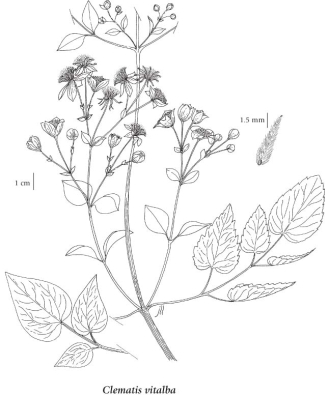traveler's joy (evergreen clematis)
Ranunculaceae (Buttercup family)
Introduction to Vascular Plants
Species Information
General:
Perennial woody vine; stems climbing, to 12 m long, grooved, sparsely hairy.
Leaves:
Opposite, long-stalked, pinnately compound, the leaflets 5, stalked, heart-shaped, to 8 cm long, 3-5 cm wide, coarsely toothed to entire, minutely-hairy on veins below, smooth above; the stalks act as tendrils.
Flowers:
Inflorescence of axillary and terminal cymes of 5 to 22 flowers, the flowers bisexual; bracts small; flower stalks slender, 1-1.5 cm long, minutely-hairy; petals absent; sepals 4 (-6), wide-spreading, white to cream, elliptic or egg-shaped to oblanceolate, about 1 cm long, about 0.5 cm wide, densely woolly-hairy on both surfaces; stamens about 50; pistils 20 or more.
Fruits:
Achenes, rounded, densely-hairy; beaks about 3.5 cm long, feathery-hairy.
Illustration

If more than one illustration is available for a species (e.g., separate illustrations were provided for two subspecies) then links to the separate images will be provided below. Note that individual subspecies or varietal illustrations are not always available.
Illustration Source: The Illustrated Flora of British Columbia
Habitat and Range
Mesic to dry roadsides and disturbed areas in the lowland zone; infrequent garden escape on SE Vancouver Island, the Gulf Islands and adjacent mainland; introduced from Eurasia and N Africa.Status Information
Taxonomic Keys
KEY TO CLEMATIS
1. Sepals blue to reddish purple......................................C. occidentalis 1. Sepals bright yellow to cream or white. 2. Sepals white; flowers imperfect; the plants dioecious, plants native.....................................C. ligusticifolia 2. Sepals bright yellow or cream, if white then the flowers perfect; plants introduced. 3. Sepals bright yellow..........................................C. tanguitica 3. Sepals cream or white.....................................C. vitalba |
Taxonomic Notes
Clematis vitalba is considered an emerging invasive species by the Greater Vancouver Invasive Plant Council (2009). An emerging invasive is defined by them as: currently found in isolated, sparse populations but are rapidly expanding their range within the region.
|